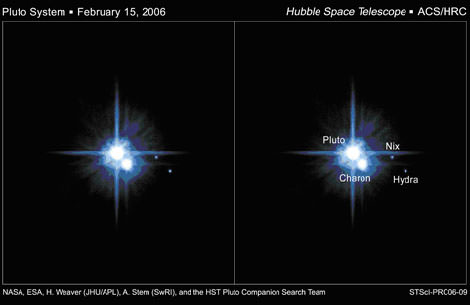Technology Review | The Physics arXiv Blog | kfc | 2011 Aug 08
Dust from Pluto's satellites ought to form a faint ring around the dwarf planet, according to new calculations.
Until recently, the only ring in the Solar System was Saturn's. But in 1960s and 70s, astronomers discovered rings around Uranus and Neptune. Meanwhile, the Voyager 1spacecraft sent back images of Jupiter's ring.
To be sure, these rings are much less impressive than Saturn's but the implications are clear: rings seem much more common than astronomers once thought. Perhaps they are even the norm.
And that raises an interesting question: could Pluto possibly have a ring?
The observational evidence is that Pluto does not have a ring. The best images are from the Hubble Space Telescope and they show nothing.
But today, Pryscilla Maria Pires dos Santos and pals at UNESP-São Paulo State University in Brazil say that Pluto ought to have a ring after all, but one that is too faint for Hubble to spot.
Their conclusion comes from modelling the way that micrometeorite impacts on Pluto's satellites, Nix and Hydra, ought to send dust into orbit about the dwarf planet.
This dust inevitably spirals into Pluto and its satellites because of its interaction with the solar wind. In this way, the dust is removed from orbit.
But that doesn't mean it can't form a ring. The important question is whether the dust can be replaced as quickly as it is removed.
Pires dos Santos and co calculate that the dust initially forms a ring about 16,000 km wide, encompassing the orbits of both Nix and Hydra. However, the solar wind then removes about 50 per cent of the dust within a year.
However, that still leaves enough to form a ring, albeit it an extremely faint one. "A tenuous ring...can be maintained by the dust particles released from the surfaces of Nix and Hydra," say Pires dos Santos and co.
They calculate that its transparency (or optical depth) has a value of 10^-11. By comparison, the main ring of Uranus has a transparency of between 0.5 and 2.5.
Hubble ought to be able to to see a ring around Pluto with a transparency of about 10^-5 so it's no surprise that it hasn't seen the ring that the Brazilian team predict. There's no way to see such a ring directly from Earth.
Fortunately, there is a way to settle the matter.
The New Horizons spacecraft is currently on its way to Pluto, equipped not with a camera capable of seeing the ring but with a dust counter that should do the trick instead. If this probe finds itself in the lightest of dust clouds when it arrives on 14 July 2015, we'll finally know for sure.
Small particles in Pluto's environment: effects of the solar radiation pressure - P. M. Pires dos Santos et al
- arXiv.org > astro-ph > arXiv:1108.0712 > 02 Aug 2011
Ring System Around Pluto?
Universe Today | Ray Sanders | 2011 Aug 09
With the New Horizons spacecraft on its way to Pluto, there may be an intriguing additional task for the mission’s science team: look for a potential ring around Pluto and its moons. Researchers at The Universidade Estadual Paulista in Brazil have recently submitted a paper for publication in which they explore the possibility of a ring system around the Pluto-Charon system. In their paper, the team discusses the effects of micrometeoroid impacts on Nix and Hydra and how the resulting dust particles could form a ring around Pluto. The team also investigates forces, such as the solar wind, which would dissipate said ring system.
Pryscilla Maria Pires dos Santos and her team provide an exhaustive list of calculations in their paper which estimates the ring system to have a diameter of nearly 16,000 kilometers – well outside the orbits of Nix and Hydra. Based on their calculations, Pires dos Santos state that despite nearly 50% of the ring’s mass being dissipated within a year, a tenuous ring system can be maintained by the dust expelled by micrometeoroid impacts.
Additional data presented in the paper places the rings “optical depth” as being several orders of magnitude fainter than even Jupiter’s rings. (Yes, Jupiter has a ring system!) While ground-based observatories and even the Hubble Space Telescope haven’t detected the ring system Pires dos Santos et al. are hopeful that the New Horizons mission will provide data to validate their theoretical models. New Horizons has a dust counter capable of measuring dust grains with a minimum mass of 10-12 grams, which should provide the data required to support or refute the team’s models.
Pires dos Santos mentions: “It is worth to point out that the interplanetary environment in the outer Solar System is not well known. Many assumptions have to be made in order to estimate a normal optical depth of a putative ring encompassing the orbits of Nix and Hydra.”

